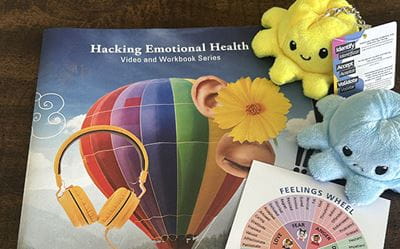😬: The face you make when you're not quite sure how to feel.
Excited? Anxious? Both?
For tweens, navigating the feelings of growing up can be hard. A program at Intermountain Health Primary Children’s Hospital supports young adolescents’ emotional well-being and helps teachers and parents nurture middle-school-aged children as they sort out their emotions.
“We saw this gap within the community where emotional literacy was getting missed, especially around the tween age,” said Stephanie Stokes, MPH, community health children’s manager at the Salt Lake City hospital. “We wanted to facilitate bite-sized learning for adults to start talking to kids about emotions.”
Children often struggle with mental health as they transition into their teenage years. Primary Children’s recognized the increasing need for emotional well-being resources for tweens and their families needing trusted, informed help.
Starting the conversation
To help determine what to focus on and how best to get upstream to the mental well-being needs of the communities they serve, the Primary Children’s community health team asked behavioral health specialists what they wish patients knew prior to visiting behavioral health clinics. The answer: how to recognize emotions and regulate them in healthy ways.
Behavioral health experts helped design curriculum for adults to start the conversation and address mental health early. The Talk to Tweens program provides a variety of tips and tools on emotional literacy so children and families can identify, accept, validate, and manage feelings.
-
The Feelings Wheel helps trusted adults look for cues that children are struggling with their emotions and aims to help name the feeling. The wheel includes more than 50 emotions as a starting point for discussions.
-
The Hacking Emotional Health Workbook offers exercises with helpful hacks for talking about and working through emotional health. From trauma response to social health, adults can use this to practice talking it out with kids.
-
These conversation starters with open-ended questions lead to more beneficial discussions between caregivers and children. Instead of “How was your day?” the starter suggests, “What was the high point and low point of your day?”

These resources and the Talk to Tweens videos offer guidance and examples to help adults facilitate important discussions on mental health so they can intervene early. As children feel more comfortable talking about their experiences and emotions, adults can spot signs of distress and know what to do next.
“If we have kids talk about how they’re feeling earlier, and trusting caregivers understand what they are feeling, then they can talk to someone sooner and get ahead of a potential crisis experience,” Stokes said.
Impact and expansion
The program’s free resources have gained significant interest from parents and teachers. In 2024, Primary Children’s distributed over 13,000 unique assets to the community.
More school districts and community organizations from across the state are reaching out to the hospital as they see the need for the resources within their communities.
“Recognizing and being able to talk about feelings has been the revolutionary part of the program,” said Michelle Jamison, community health program manager at Primary Children’s. “Our efforts are gentle enough that we can have an impact on this big public health problem.”
While most of the current outcome metrics are measuring the program’s reach, Stokes and Jamison are also looking at other metrics including self-reported mental distress and emergency department rates and hospitalizations related to behavioral health.
The hospital also plans to develop tools tailored for younger age groups and expand to a developmental milestone approach. Stokes and Jamison are working to create emotional well-being resources on how to regulate feelings during the early brain development years from zero to three.
Engaging the experts
As children’s hospitals across the country are having conversations on the mental and behavioral health crisis, Stokes encourages organizations to engage behavioral health clinicians early.
“Behavioral health leaders are going to be your best friends,” Stokes said. “It adds power to whatever you design so you can better serve those who are hurting and feeling vulnerable.”


